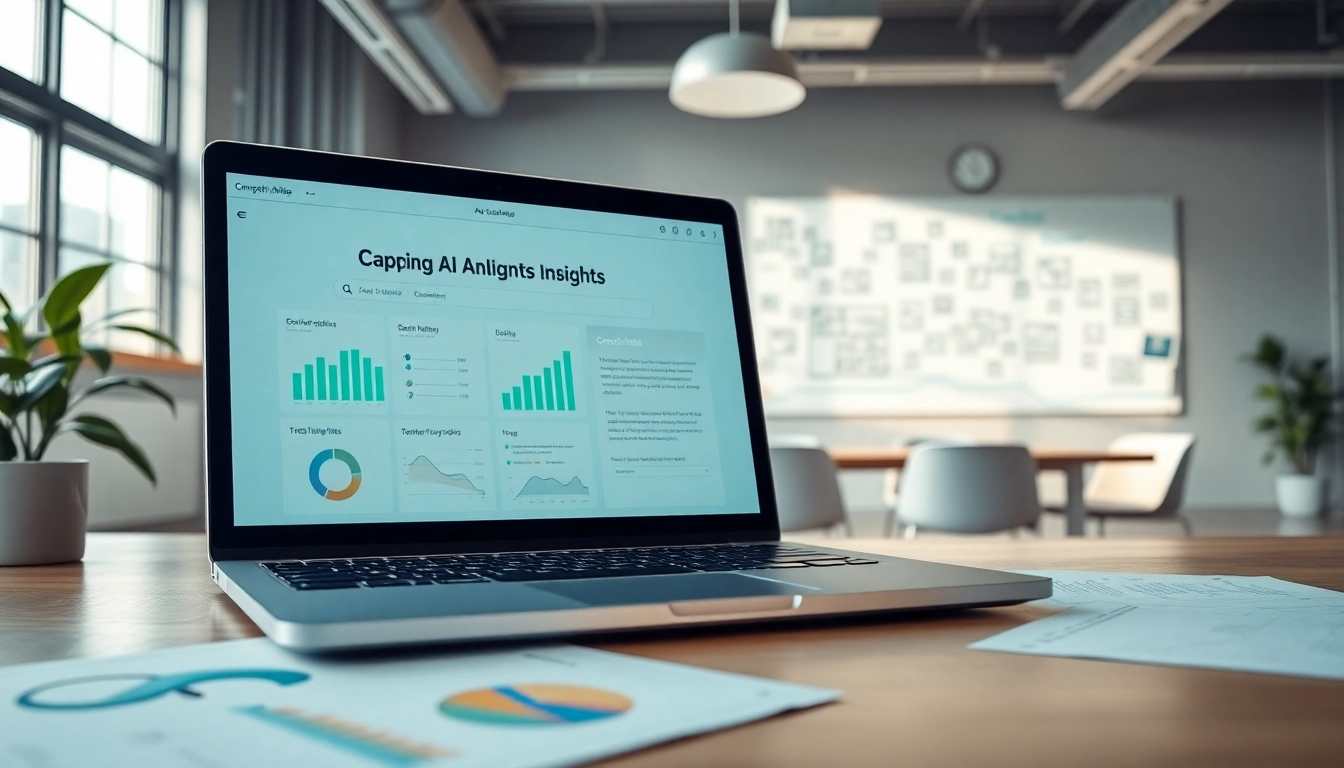Understanding Competitor Analysis
What Is Competitor Analysis?
Competitor analysis is the process of identifying and evaluating your competitors in the market to understand their strengths and weaknesses relative to your own business. This analysis enables businesses to strategize effectively by identifying opportunities and threats in their market space. It involves a thorough investigation of various elements, including competitors’ product offerings, marketing strategies, pricing models, customer service, and market positioning. The insights gained through competitor analysis can inform decisions ranging from product development to marketing campaigns, ultimately leading to a competitive advantage.
Importance of Competitor Insights
Understanding your competitors provides essential insights into market trends, customer preferences, and emerging technologies. By analyzing competitors, companies can:
- Identify Market Gaps: Recognize areas where rivals may be falling short, presenting opportunities for your business to fill.
- Benchmark Performance: Evaluate how your products, services, and marketing strategies measure against those of competitors.
- Enhance Product Development: Gain insights into customer feedback on competitors to improve or innovate your offerings.
- Inform Pricing Strategy: Understand competitors’ pricing models to strategically position your pricing in the marketplace.
- Adapt Marketing Strategies: Analyze what promotional methods competitors are using successfully and adapt these tactics to enhance your visibility.
Common Challenges in Competitor Analysis
Despite its importance, conducting competitor analysis can present several challenges such as:
- Data Accessibility: Obtaining accurate and comprehensive data about competitors can be difficult, as many companies do not disclose detailed financial information or strategic plans.
- Dynamic Markets: The rapid pace of change in markets makes it challenging to keep analysis current. Competitors may pivot quickly based on market conditions.
- Data Overload: The sheer volume of information available can be overwhelming, making it hard to filter relevant insights from irrelevant noise.
- Bias and Assumptions: Analysts may apply personal biases when interpreting competitor actions or may rely on outdated assumptions about market trends.
Crafting AI Prompts for Competitor Analysis
Essential Elements of a Good Prompt
Creating effective ai prompts for competitor analysis requires specific elements to ensure that the insights generated are actionable and relevant:
- Clarity: The prompt must be clear and straightforward to avoid confusion and ensure that the AI understands the intent behind it.
- Specificity: Including specific details about the competitors or market segments will guide the AI to deliver precise and useful insights.
- Context: Providing context such as market conditions, customer segments, or particular challenges can enhance the quality of the output.
- Action-Oriented: Prompts should ideally request actionable insights rather than general knowledge, focusing on what can be done with the information.
Examples of Effective AI Prompts
Here are some examples of prompts that can provide valuable insights during a competitive analysis:
- “List the top three competitors in [specific industry] and summarize their strengths and weaknesses.”
- “Analyze the social media marketing strategies of [Competitor A] and [Competitor B]. What are their engagement rates?”
- “Identify the most common customer complaints about [Competitor C]’s products and suggest potential improvements.”
- “What are the pricing strategies of the leading companies in [specific market]? Compare features and services offered.”
Tailoring Prompts for Specific Industries
Different industries may require tailored prompts to yield the most relevant insights. For example:
- Technology: “What are the emerging trends in AI that competitors in the fintech space are utilizing?”
- Retail: “Evaluate the product return policies of major players in e-commerce and their impact on customer satisfaction.”
- Healthcare: “How are competitors addressing the regulatory challenges in telehealth services?”
Utilizing AI in Analyzing Competition
Advantages of AI Tools
Leveraging AI tools for competitor analysis offers numerous advantages:
- Efficiency: AI can quickly process large amounts of data, enabling faster analysis than manual approaches.
- Data-Driven Insights: AI tools can uncover patterns and correlations that human analysts might miss, leading to more informed decisions.
- Real-time Analysis: AI systems can provide up-to-date information continuously, allowing businesses to adapt strategies on the fly.
- Scalability: AI can be applied across various markets and segments without needing extensive resources, making it a cost-effective solution.
Integrating AI Insights into Strategic Planning
To effectively integrate AI-generated insights into strategic planning, consider the following steps:
- Define Objectives: Clearly outline what you want to achieve with competitor analysis to guide the data gathering process.
- Engage Stakeholders: Involve relevant teams in the analysis process to ensure that insights align with overall business goals.
- Interpret Data: Use AI insights as a starting point and complement them with human expertise to derive actionable strategies.
- Monitor Progress: Continuously evaluate the effectiveness of implemented strategies and make adjustments based on new insights.
Case Studies: Successful AI Implementations
Numerous companies across various industries have successfully utilized AI in their competitive analysis:
Case Study 1: Retail Giant
A leading retail chain adopted AI-powered analytics to scrutinize market trends and customer preferences. By utilizing AI insights, they identified a gap in their product offerings and introduced a new line that resulted in a 20% increase in market share.
Case Study 2: Tech Innovator
A software company leveraged AI to analyze customer sentiment regarding competitor products. This analysis led them to rethink their own customer service approach, improving satisfaction rates and reducing churn.
Performance Metrics for Competitor Analysis
Key Metrics to Consider
When conducting competitor analysis, it’s essential to evaluate key performance metrics to understand market positioning:
- Market Share: Determine your position relative to competitors and identify growth opportunities.
- Customer Acquisition Costs: Analyzing how much competitors spend to acquire customers can inform your own strategies.
- Customer Retention Rates: Understanding how competitors retain customers can help you develop strategies to improve your own retention.
- Engagement Metrics: Evaluate customer engagement across different platforms to discern what strategies are working.
Measuring the Impact of AI Insights
To assess the impact of insights gained through AI, businesses should:
- Track Implementation: Monitor newly implemented strategies and their results over time to measure effectiveness.
- Gather Feedback: Collect feedback from clients and stakeholders regarding changes implemented based on AI analysis.
- Conduct Regular Reviews: Regularly revisit competitor analysis insights to ensure ongoing relevance and effectiveness.
Adjusting Strategies Based on Analysis
Insights from competitor analysis should not only inform current strategies but also lead to agile adaptations. Companies should establish a culture of continuous improvement where:
- Flexibility: Be prepared to pivot strategies based on competitor movements or market changes.
- Innovation: Use the insights gained to inspire innovative products or marketing campaigns that better resonate with target customers.
Future Trends in Competitive Analysis
The Role of AI in Future Market Research
As AI technology advances, its role in market research will become even more critical. Future trends may include:
- Predictive Analytics: Utilizing machine learning algorithms to forecast future market behaviors based on historical data.
- Enhanced Data Visualization: Advanced AI tools will offer more intuitive visualization capabilities for interpreting complex data sets.
Emerging Techniques for Competitor Analysis
Emerging techniques may involve the use of real-time social media monitoring, sentiment analysis, and even virtual reality for gaining immersive insights into competitors’ market strategies. Keeping abreast of these techniques will provide companies with an edge in strategy formulation.
Preparing for an AI-Driven Competitive Landscape
To thrive in an increasingly AI-driven competitive landscape, companies should focus on building robust data strategies, fostering a culture of innovation, and continuously adapting to technological advancements. Investing in talent and tools that can leverage AI insights effectively will be critical for long-term success.



